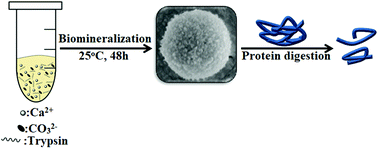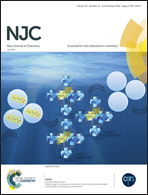A trypsin–calcium carbonate hybrid nanosphere based enzyme reactor with good stability and reusability†
Abstract
Controlled fabrication of CaCO3 nanoparticles with an exquisite polymorph and morphology has received intensive attention due to their broad industrial and biomedical applications. Herein we have created trypsin–CaCO3 hybrid nanoparticles with a well-controlled morphology and a crystal phase via a very mild biomineralization process. The incubation of a mixture of sodium carbonate and calcium chloride at room temperature using trypsin as the biotemplate leads to predominantly calcite mesocrystals with porous sphere-like nanostructures. The trypsin–CaCO3 hybrid nanospheres behave as superior nano-biocatalysts, which display high stability against thermal and chemical denaturation as well as excellent reusability. We have demonstrated that trypsin not only acts as a novel robust biotemplate to mediate the growth of CaCO3 crystals, but also enhances their biological properties as an excellent enzyme. This indicates that biomineralization may provide a facile and environmentally amiable approach to immobilize enzymes on calcium carbonate nanoparticles. Our studies could greatly enhance the understanding of the mechanism of the protein-mediated biomineralization of CaCO3, and extend the applications of CaCO3-based composite nanostructured biomaterials.



 Please wait while we load your content...
Please wait while we load your content...